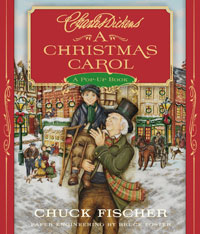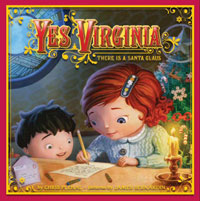A Christmas Carol: A Pop-Up Book, written by Charles Dickens, engineered by Chuck Fischer, Hatchette Book Group, $30, ages 9 and up, 12 pages. The stunning novella that made Dickens weep and laugh, and weep again as he wrote it, A Christmas Carol, is faithfully reproduced in all of its Victorian splendor in this lushly painted pop-up. Harking back to vintage pop-up greeting cards, the scenes unfold on cobbled streets lit by gas lamps or in grand rooms in Ebenezer's house, some with ornate swags of holy around the edges, others with dark wood furniture and red velvet curtains. Perhaps best-loved of all Christmas stories, the tale of human redemption begins on the streets of London as a scowling Scrooge steps out of his business into the languishing light of early evening. Each of the next four pop-ups show the miser reacting with fright as the four spirits show him the folly of his ways.
First, Marley's ghost, then the Ghosts of Christmases Past, Present and Future, appear from seemingly nowhere, one through a door, another out of a candle flame, the next from a table set with a feast, and finally, the most chilling of them rising from a graveyard, his face shrouded by a cloak. At the bottom of every spread, tucked into a pocket, is a booklet with the "stave" or chapter that's illustrated, or in the case of the first booklet, an essay about the novella's enduring appeal. One can't help think that Dickens would approve of this grand depiction, especially when reminded of the lavish binding, gilt edging and hand-colored illustrations that Dickens insisted upon for his book's first edition in 1843. Respectful and glowing with warmth, Fischer adaptation conveys the depth of Carol's desire for a more kind and forgiving world.
First, Marley's ghost, then the Ghosts of Christmases Past, Present and Future, appear from seemingly nowhere, one through a door, another out of a candle flame, the next from a table set with a feast, and finally, the most chilling of them rising from a graveyard, his face shrouded by a cloak. At the bottom of every spread, tucked into a pocket, is a booklet with the "stave" or chapter that's illustrated, or in the case of the first booklet, an essay about the novella's enduring appeal. One can't help think that Dickens would approve of this grand depiction, especially when reminded of the lavish binding, gilt edging and hand-colored illustrations that Dickens insisted upon for his book's first edition in 1843. Respectful and glowing with warmth, Fischer adaptation conveys the depth of Carol's desire for a more kind and forgiving world.
Yes, Virginia, There is a Santa Claus, written by Chris Plehal, pictures by Ames Bernardin, HarperCollins, ages 4-8. As captivating as Arthur Rankin's The Year Without a Santa Claus, Bernardin's illustrations turn a sweet retelling of the story behind Virginia O'Hanlan's 1897 letter to The Sun into something wondrous. Plehal's debut brings back the story of real-life Virginia, who at 8 years old asked her father if there really was a Santa. Not knowing how to answer her question, her father encouraged her to write a letter to the editor of New York City's The Sun, and reassuringly said, "If you see it in The Sun, it's so." The Sun's editor Francis Church went on to address her question in one of the most reprinted editorials ever to run in an English language newspaper. In this retelling, Church is a sour fellow and reacts incredulously that anyone would ask such a question. "This is preposterous!" he yells to his assistant, before throwing out her letter. "We report facts, not fantasies!" In the meantime, Virginia keeps looking in the paper, wondering why
0 Comments on 40. Christmas Magic: 3 Favorites as of 1/1/1900
Add a Comment




